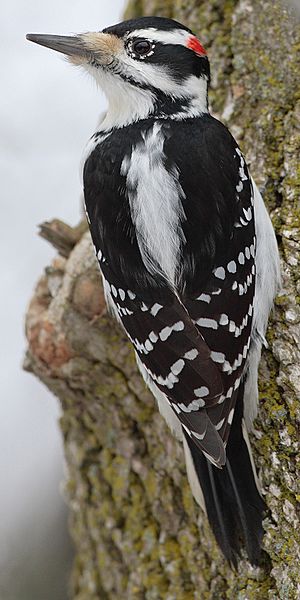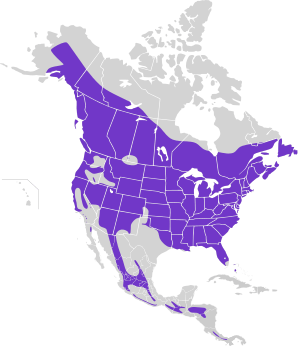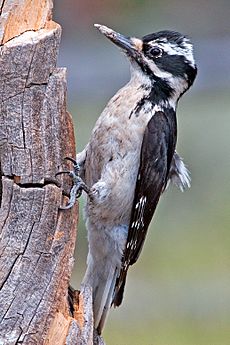Hairy woodpecker facts for kids
Quick facts for kids Hairy woodpecker |
|
|---|---|
 |
|
| Male, eastern subspecies septentrionalis | |
| Conservation status | |
| Scientific classification | |
| Genus: |
Leuconotopicus
|
| Species: |
villosus
|
 |
|
| Synonyms | |
|
|
The hairy woodpecker (Leuconotopicus villosus) is a medium-sized woodpecker found across a large part of North America. It's about 25 centimeters (10 inches) long with a wingspan of about 38 centimeters (15 inches). In 2003, there were over nine million hairy woodpeckers. Because of their large numbers, they are not considered an endangered species. They are listed as a species of least concern by the IUCN.
Contents
Understanding the Hairy Woodpecker's Name
The hairy woodpecker's scientific name is Leuconotopicus villosus. This name helps scientists around the world know exactly which bird they are talking about. The word villosus is Latin for "hairy," which describes this bird well.
A long time ago, in 1766, a Swedish scientist named Carl Linnaeus gave this bird its first scientific name, Picus villosus. Over time, scientists learn more about animals through studies like molecular phylogenetics (looking at their DNA). Based on these studies, the hairy woodpecker was moved to a new group, or genus, called Leuconotopicus.
There are many different types of hairy woodpeckers, called subspecies. These subspecies look a little different or live in different areas. For example, L. v. septentrionalis lives in western North America, while L. v. villosus lives in southeastern Canada and the northeastern USA.
What the Hairy Woodpecker Looks Like
Adult hairy woodpeckers are mostly black on their backs and wings. They have a white or pale stripe down their back and white spots on their wings. Their throat and belly can be white or a smoky brown color, depending on where they live. They also have a white stripe above and below each eye. Their tail is black with white outer feathers.
Male hairy woodpeckers have a bright red patch on the back of their head. Young males might have a red or orange-red patch on the top of their head.
Hairy woodpeckers are usually between 18 and 26 centimeters (7 to 10 inches) long. Their wingspan is about 33 to 43 centimeters (13 to 17 inches), and they weigh between 40 and 95 grams (1.4 to 3.4 ounces).
Hairy vs. Downy Woodpecker
The hairy woodpecker looks almost exactly like the smaller downy woodpecker. It can be tricky to tell them apart! The best way to tell them apart is by their bill. The downy woodpecker has a much shorter bill compared to the size of its head. The hairy woodpecker's bill is longer, almost as long as its head.
Another clue is the white outer tail feathers. The hairy woodpecker has plain white outer tail feathers, but the downy woodpecker has small black spots on its white outer tail feathers. Even though they look so similar, these two species are not closely related. This is an amazing example of convergent evolution, where different species develop similar features.
Where Hairy Woodpeckers Live
Hairy woodpeckers live in mature deciduous forests across many countries. You can find them in places like Canada, the United States, Mexico, and parts of Central America like Costa Rica and Panama. They also live in the Bahamas. Sometimes, they might wander to places like Puerto Rico.
These birds usually stay in the same area all year round. They are called "permanent residents." However, some birds that live in very cold northern areas might migrate south for the winter. Those living in mountains might move to lower areas when it gets cold.
When it's time to have babies, mating pairs will dig a hole in a tree. Inside this hole, the female will lay about four white eggs.
How Hairy Woodpeckers Live
Hairy woodpeckers spend their time looking for food on trees. They often turn over bark or dig into the wood to find insects. Their main food is insects, but they also eat fruits, berries, and nuts. Sometimes, they even drink tree sap.
These woodpeckers are helpful because they eat pests like the European corn borer. This moth causes a lot of damage to corn crops in the United States. Hairy woodpeckers are also known to peck at wooden window frames and wood-sided homes. They do this because there might be insects hiding in the wood.
Gallery
Images for kids
-
A Hairy Woodpecker mother feeding its chick through a hole in a Chinese Tallow Tree branch.
-
A Hairy Woodpecker male, which was helping feed a chick, has noticed the photographer and is not happy. Photographed in Hattiesburg, Mississippi.
See also
 In Spanish: Pico velloso para niños
In Spanish: Pico velloso para niños










